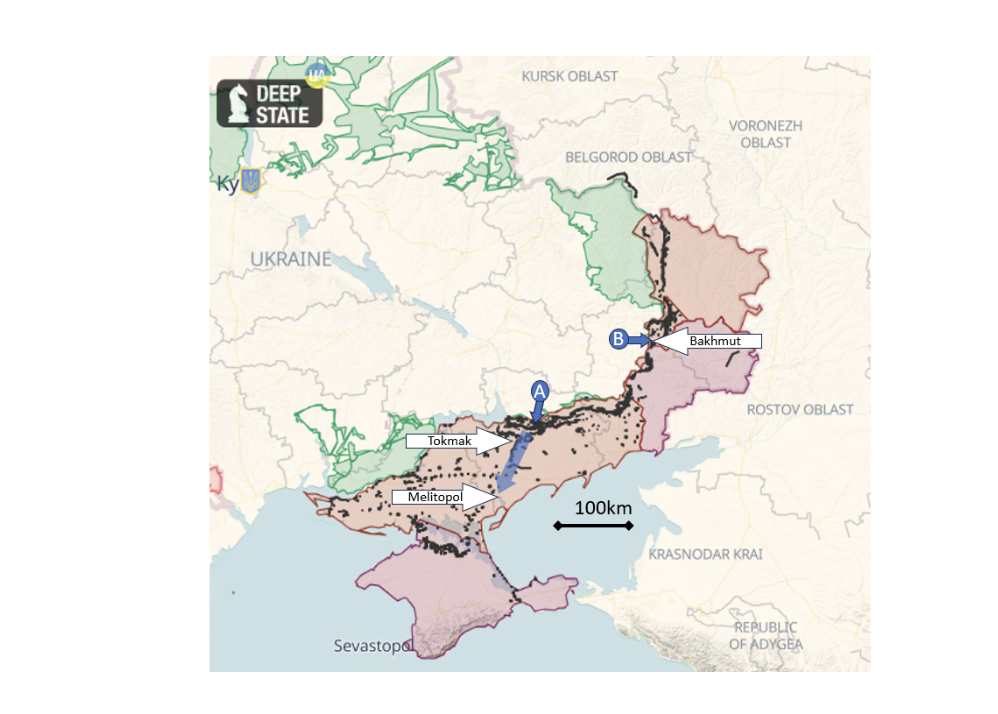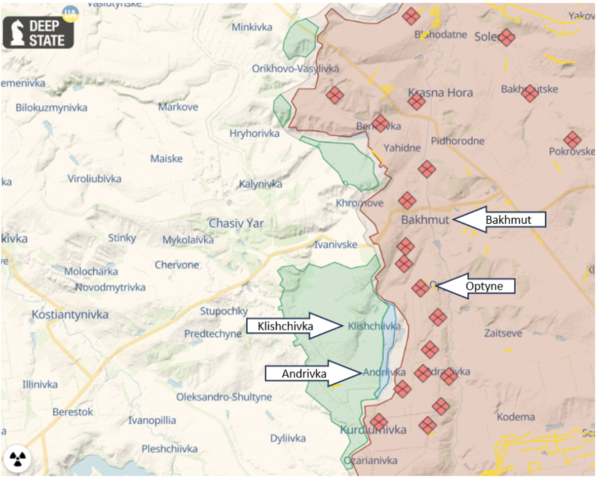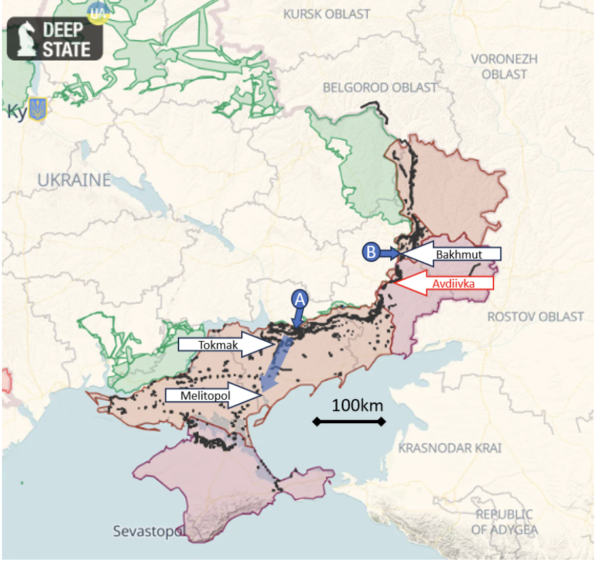Ukraine spent last week battling hard, on the frontline its forces are bogged down in intense fighting and facing new Russian attacks. Ukraine’s key strategic issue remains keeping the attention of its international supporters a tougher task now that world media attention is focussed on Gaza. Ukraine relies on ammunition, equipment and money from other countries to continue its war against a much larger enemy. Recent slow progress in the land campaign inevitably leads to questions about the effectiveness of the billions of dollars of aid provided to Ukraine.
Ukraine is trying to manage the risk of losing international support by generating income from grain exports. Controlling the western Black Sea is important for Ukraine because it provides safe access for grain shipments that will deliver essential income. Last week, Ukraine continued to focus on this objective attacking another two Russian warships. The small patrol vessel Pavel Derzhavin on 11 October and Buyan a missile armed corvette on 13 October. It has been confirmed that Pavel Derzhavin was damaged and needs repairs. This ship is a stealthy and modern vessel that was hit near Sevastopol. Hitting a vessel like that at this distance, demonstrates both Ukraine’s technical capabilities and how useful the Boyak Towers are for surveillance and targeting. The attacks are further evidence that Ukraine controls the western Black Sea. A situation causing Russia considerable concern because of the options to attack Crimea or the south-west Kherson coast it gives Ukraine.
Evidence that Russia is worried was reported by the Institute for the Study of War, on 13 October. The Institute reporting movement of Russian troops from reserve positions into south-west Kherson to defend against an attack over the Dnipro River or from the coast. The Institute referenced Ukrainian analyst Kostyantyn Mashovets, reporting that he believes “…that the Russian military command is adjusting its posture in the Kherson and Crimea directions in response to concerns about the possibility of a large-scale Ukrainian crossing of the Dnipro River and the development of Ukrainian offensive operations targeting Crimea.” The chances of Ukraine crossing the Dnipro River in large numbers is low. However, Ukraine’s increasing control of the Black Sea may contribute to Russian fears of an attack from this direction.
Russia’s movement of troops from the Zaporizhia frontline into south-west Kherson raises an important question. If Russia’s defences are as stretched as reported, how can Russia justify deploying resources for this task? Russia either very firmly believes Ukraine intends to open a new front by crossing the Dnipro River. Or, conversely it could mean that Russia is sufficiently in control of the situation that they feel safe moving troops from contested areas to south-western Kherson. It is a very interesting situation and worth keeping a close eye on, especially considering recent changes in the ground battle.
On land, Ukraine started last week continuing to concentrate on two key axes of advance:
- A southern axis starting from near Orikhiv and pushing south towards Tokmak and Melitopol. This is the most important axis and is likely to be Ukraine’s main effort.
- Advancing on Bakhmut, an offensive that is probably designed to hold Russian forces in this area, often called a ‘fixing’ operation because it prevents Russia moving troops from Bakhmut to defend in the south

Starting on the southern axis, Ukraine is still fighting hard to ‘break into’ Novoprokopivka and Verbove. Russia has managed to concentrate some of its strongest units in this on this axis and is reported to be successfully rotating forces in this area, allowing its soldiers to rest, re-arm and recuperate. The fighting is now in urban areas so combat is intense. Even small villages are difficult targets that are easy to defend. This week, regardless of Ukraine’s best efforts there has been no forward movement on this axis. Nor has Ukraine been able to expand the width of its salient by pushing either west toward Kopani or east toward Verbove.
Further east, Ukraine’s operations around Bakhmut have been more successful. Ukraine advancing east about 1-1.5 kilometres on a six-kilometre frontage. The contested area shown on Deep State’s map (below) shows that it is possible Ukraine has pushed Russian forces back from the defensive line they had established on the rail line that supplies Bakhmut from the south. Railway embankments provide a useful obstacle to movement and are a natural line of defence. The question this battle raises is: Where next? North toward Bakhmut; or east towards Optyne?

If Ukraine captures Optyne, to the east, it means they will control Russian access to the area on the T0513 Highway a major supply route for Russia’s soldiers in Bakhmut. Getting to Optyne though requires crossing several small water courses and boggy ground before advancing uphill to take the town. The other option, advancing north to Bakhmut may be an easier task, involving an advance on a gentle downhill slope towards the city.
Later in the week, there was an increase in Russian activity with attacks launched along most of the front line. Most were small and easily defeated. The largest is a surprise attack on the Avdiivka salient (see the map below). The attack started on 11 October with offensives from both the north and south flanks of the Ukrainian salient. Fighting continues and although Russian forces made some small gains in the north they were generally pushed back and, in some areas, heavily defeated. Setting off a furore in the Russian military blogging community. The bloggers upset by another failed Russian attack.
The operation started just after the Hamas attack on Israel and may be part of a larger Russian information operation designed to undermine confidence in Ukraine while the world’s attention is diverted. The Institute for the Study of War, assessing on 13 September that “The Kremlin is likely attempting to frame Russian offensive operations around Avdiivka and other localized efforts as Russian forces seizing the operational initiative in Ukraine.”

Reviewing the land campaign, it seems safe to conclude that Russia feels comfortable that it can hold Ukraine on the Orikhiv Axis. Evidence being the movement of forces west to defend south-west Kherson and Crimea and the large commitment of troops to the Aviidivka operation. Both of which indicate a level of confidence that Ukraine’s offensive in the south can be held. However, the Institute for the Study of War is probably correct that Russia’s attacks, including the Aviidivka operation are also about demonstrating that Ukraine has lost operational initiative. Russia’s attacks contributing to a narrative that supporting Ukraine is supporting a lost cause.
In the United States there is already tension amongst policy makers about the $ 44 billion invested in the war to date and even though, Defence Secretary Lloyd Austin announced another $ 200 million on 11 October the tension will increase. A presidential election is fast approaching and there are candidates for whom the investment in Ukraine is an example of the United States paying for other people’s wars. Arguing that European nations should pay for the defence of Europe rather than it being subsidised by the United States. If Ukraine is not demonstrably ‘winning’ these arguments gain traction.
Russia’s United Nations representative, Vasily Nebenzia contributed to this narrative stating that “Russian troops have, for several days now, switched over to active combat action practically throughout the entire frontline” and that “The so-called Ukrainian counteroffensive can therefore be considered finished.” Nebenzia’s statement is clearly propaganda, the offensive is contained to a relatively small area of the front and to date is far from successful. John Kirby, America’s national security spokesperson admitted that the Russian attack on Aviidivka was a new offensive but was confident that Ukraine would defeat it. Kirby and his administration will be worried about the effects of this discussion on forthcoming United State budget debates.
Further, Nebenzia’s statements fly-in the face of Ukrainian information stating that the average number of artillery shells fired by Ukraine each day has surpassed the number fired by Russia for the first time in the war. Consumption of artillery ammunition is an important combat indicator, one that in this case suggests Russia’s capacity is reducing and while Ukraine’s is increasing. A result that should not be surprising because Russia used enormous quantities of shells to demolish Ukraine’s cities early in the war. Shells that came from war stocks and cannot be replaced easily because Russia’s manufacturing capacity is too small. Even with supplies from North Korea, Russia will struggle to match the capacity of Ukraine’s supporters. If this is correct, it may be that the Aviidivka operation is not inspired by a confident appreciation of activity in the south but by a desperate need to reduce support from the United States and its allies by presenting the narrative that Ukraine’s offensive is beaten and a new Russian offensive is starting.
In summary, last week was full of interesting and contradictory activity that raises questions about the land campaign. Perhaps Russia is confident that Ukraine’s southern thrust is defeated, so can risk starting offensives and moving troops to cover a highly unlikely axis of attack from across the Dnipro River. Or, maybe the Russian’s have good reason to be worried and the Ukrainians do have options for attacking Crimea or for crossing the Dnipro River, that are not public yet but that scare the Russians enough to risk taking troops from the frontline. Meanwhile, we can be sure that Russia is preparing for the winter, NATO Secretary-General Jens Stoltenberg noting this week that Russia is “preparing once again to use winter as a weapon of war” highlighting NATO’s expectation that Ukraine’s power infra-structure will again be targeted by Russia. Further we can assume that Russia will continue to try to convince Ukraine’s supporters that no matter how much resource they provide the war will go on forever, that Russia will not give up. A powerful information operation fought by covert social media campaigns, media releases, political statements and that shapes operations in the campaign. By taking the offensive last week Russia contributes to telling this story, reinforcing propaganda with activity on the ground. Selling the story that Ukraine has culminated and now Russia will strike back, demonstrating that the support provided to Ukraine is not working. A narrative that the world can not afford to let become the truth.
Ben Morgan is a bored Gen Xer and TDBs military blogger


So far Ben you’ve had the UA driving down to Maruipol through 3 lines of the Surovikin line for every week of the last 5 months. It’s not just laughable, it’s pathetic.
Ben needs to give it up, it’s a lost cause. Trying to convince anyone in the East, West, North or South that
Ukraine has any chance of winning this war. Everyone can see Ukraine is being utterly destroyed in every way as has been the case since the 2nd phase started (Donbass).
Last week it was reported that approx. 1000 shipping containers of ammo had arrived in Rostok-on-Don from North Korea.
Ukraine needed longer range missiles to destroy that before it was distributed to the front.
Andrew, we’d better hope to hell that report is wrong or it means death to press ganged 16 year olds and 40+ year olds. Madam Z has been spending enough on high grade luxuries and new villas whilst Ukrainian troops die. You and I and the whole West is paying for this corruption. Wake up.
Rostov
drones are the new artillery – I wonder what Xi is going to offer not offer but give anyway.
How is your ancient keyboard wearing, Teddy-Boy?
Palestine?
No-Comment?
C’mon Ben, do your thing for the war in Gaza.
If You Support Ukrainian Resistance to Occupation, You Must Also Support Palestinian Resistance to Occupation
Nathan J. Robinson
filed 05 July 2023 in ISRAEL/PALESTINE
https://www.currentaffairs.org/2023/07/if-you-support-ukrainian-resistance-to-occupation-you-must-also-support-palestinian-resistance-to-occupation?fbclid=IwAR1-mySsIkyGIxIteLQ-WVn47hEkX10Cct_nW-nY5LZN-5hYMtjFEiE8xHI
It’s hard to read the progress in an attritional strategy, which mostly comes down to pressure on fronts. The best sign for Russia was that they were able to contain and repulse the special forces strikes on western Crimea, which could have produced a decisive outflanking of that supply route. Less positive for them have been Russian adventures on the Kharkhiv front that look like the worst efforts of Melchett & Blackadder. Unless US support evaporates, Ukraine’s wearing down of Russian capabilities seems set to continue.
Stuart, your comments echo an attitude similar to those idiots in 1941 who thought to “kick the rotten door down “. It is a form of exceptionalist thinking that so many in the West adhere to. Reality is however a spiteful bitch.
ukrainians should give up and go home – lol – oh wait. russian settlers should go home. oh wait. the isralei prez was first to viist. ” you know vlad, if you want to move people on, you have to agitate them and then let them believe there is hope”. Then, dash it on the rocks of IDGAF and throw in a few militants. lol – I’ve read enough war stories to know they’re all the fuckin same.
In your dreams Antforce62. It is still all on in Ukraine at the moment. It is not over! Russia are taking huge equipment and manpower losses of late for overall net loss of occupied territory. USA has stated they have the capability and intention to support both Ukraine and Israel at the same time on in to the future.
Dream on.
Biden is now going to send ATACMS with a range out to 300kms in all variants to Ukraine not just the shorter range type with bomblets that did the aircraft & airfield damage in Berdiansk and Luhansk. Substantial continuing aid for Ukraine is likely to be passed by the USA government in the second week of November. By 2024 F16’s will be on the battlefield creating further problems for the already suffering Russian airforce. (They lost five fighter bomber jets near Ardiivka in just the last week) How much attrition are the Russians willing to suffer before leaving the occupied territory?
Simplicius totally debunks your claims Trev. He’s pro Russian though so even if he’s right you will prefer Ukrainian propaganda and fairytales. And so far he’s proven very accurate despite his preferences, primarily because he doesn’t let preference interfere with facts and reality.
Comments are closed.